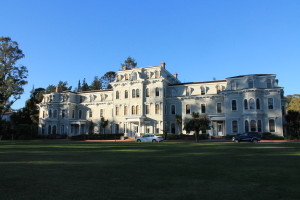
The small San Francisco gallery was jam-packed with guests – the mood was both familiar and energized as visitors anticipated the start of the open mic and dance performances.
The Associated Students Art Gallery at the Cesar Chavez Student Center of San Francisco State University (SFSU) was transformed to showcase the stories of Pacific Islanders across Oceania.
Open to the public on Oct. 13, the gallery, entitled Being Pacific, chronicles Pacific Islander art and activist struggles, and features the cultural and historical narratives of artists from the islands.
The white walls of the gallery were etched with the words of Pacific scholars, which included a prayer-like invocation from Fijian and Tongan writer Epeli Hau’ofa: “Oceania is vast, Oceania is expanding, Oceania is hospitable and generous, Oceania is humanity rising from the depths of the brine and regions of fire deeper still, Oceania is us. We are the sea, we are the ocean…”
A founding member of the university’s Pacific Islanders Club set up camp at a fold-out table in the entrance of the gallery and sold copies of Our Sea of Islands that was created by Pacific Islanders. The booklet featured both writing and visual art. One essay, written by Bay Area-based filmmaker and arts educator Kapi’olani Lee, contested the grouping of Pacific Islanders with Asian Americans. Lee writes: “API, or Asian Pacific Islander, is a relatively new rubric that contains nearly 70 different ethnic groups, with no shared language or collectively held historical experience. It is a large, bustling umbrella of people with a wide spectrum of needs that are barely met by the funding allocated to ‘API’ issues, let alone Asian American ones.”
An installment by Chamorro artist Kerri Ann Borja featured a piece of driftwood draped with traditionally carved shell necklaces, ranging in color from delicate pinks to vibrant oranges, each strung on a sturdy black cord. These shell necklaces have become a way for Chamorros, particularly those in the diaspora, to recognize one another and to anchor themselves to a sense of home.
While attending SFSU as an undergraduate student, Borja enrolled in the first ever Pacific Islander studies course offered at the university. After the spoken word performances and opening remarks, visitors and artists lingered and struck up conversation. Standing next to her art, Borja described a phone conversation with her father that “flipped things” for her and sparked her activism. For Borja, the gallery is situated within a long process of both artistic and political work. Borja’s father brought up Liberation Day, an annual holiday in Guam to celebrate the end of the Japanese occupation of World War II with the arrival of American soldiers.
“He had told me, ‘I think it’s funny how Chamorros celebrate Liberation Day because the U.S. didn’t come in and liberate Guam.’ He’s said, when you liberate a country, you go in and you do what you need to do and then you leave. The U.S. didn’t do that. They came and they stayed. They occupied the island and they continue to occupy the island,” Borja said.
In 2012, Borja, Richard Benigno Cantora, Andrew Fatilua Tunai Tuala and David Ga’oupu Paulita edited “Matamai2: Intersecting Knowledge across the Diaspora,” a collection of writing by Pacific Islander studies students at SFSU and City College of San Francisco (CCSF). At the reception of Being Pacific, Paulita held up a copy of “Matamai2” during his opening remarks and praised the book as an example of the history of organizing and collaborative art between the two schools.
The gallery also featured a framed copy of “The Stake Pacific Islanders Have In Ethnic Studies,” a letter expressing solidarity from SFSU’s Pacific Islanders’ Club with the College of Ethnic Studies’ protest against SFSU president Leslie E. Wong’s proposed budget cuts to the college. The letter expressed a demand for “proper representation within the college of Ethnic Studies, separate from Asian American studies.” For many Pacific Islander students, ethnic studies has become a department where one can find the resources and facility to engage with their histories and cultures.
As the letter illustrates, this space of belonging is also a space of friction. The gallery curators see the ocean as a metaphor for bringing many Pacific cultures together.
The Being Pacific curatorial pamphlet features another quote from Hau’ofa: “We should not be defined by the smallness of our islands, but by the greatness of our oceans…We must wake up to this ancient truth and together use it to overturn all hegemonic views that aim ultimately to confine us again, physically and psychologically. It is time to create things for ourselves, to create established standards, or excellence that matches those of our ancestors.”
Those words, like the ocean itself, unite the voices of the Pacific.
The Being Pacific gallery will run Monday to Friday, 11 a.m. to 6 p.m., until Nov. 10.



